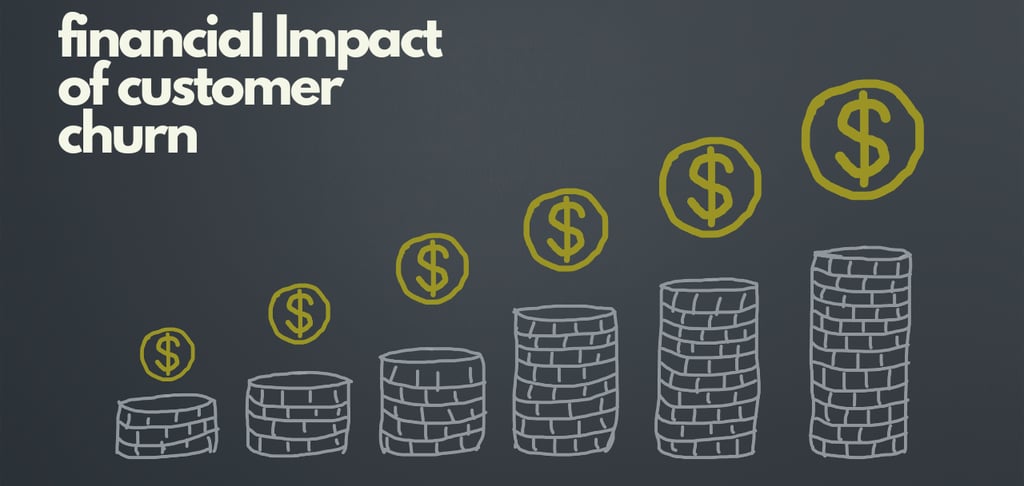The Financial Impact of Customer Churn
Understand the financial impact of customer churn on early-stage B2B companies. Learn how churn affects revenue, acquisition costs, customer lifetime value, cash flow, and brand reputation, and discover strategies to mitigate these effects.
CUSTOMER EXPERIENCE
Joseph Loria
7/23/20242 min read


Customer churn – the silent revenue killer.
It happens time and time again at early-stage companies — the priority is growth at all costs through new client acquisition, and overlooking the importance of customer retention.
But once a business begins to grasp the full financial impact of customer churn on their bottom line, they start to take the appropriate steps in prioritizing retention.
Let’s explore the different ways customer churn impacts a company’s bottom line and what you can do about it.
5 Ways Customer Churn Hurts Your Bottom Line
1) Revenue Loss
Losing customers = losing revenue.
Take for example, a SaaS company with a 20% churn rate where each customer is worth $10,000 annually. They would lose $2 million annually at 200 customers churning.
That’s a lot of money leaving the table!
But it’s not just the immediate revenue loss. When a customer leaves, the potential revenue from upsells, renewals, or referrals leaves with them. Having lasting impacts on your business and your bottom line.
2) Increased Acquisition Costs
The cost of keeping a customer < the cost of acquiring a new one.
When churn rates are high, businesses have to spend more money (and time) to make up for lost customers, thus, driving up customer acquisition cost (CAC).
Increased Acquisition Costs Lead To:
Higher Marketing Expenses: More money spent on advertising campaigns to attract new customers.
Increased Sales Efforts: More resources allocated to sales teams to close new deals.
Training and Onboarding Costs: The cost of training new customers to replace those who churned.
3) Lower Customer Lifetime Value
Customer lifetime value (LTV) is the total revenue a customer brings over their lifetime with your company.
High churn rates lead to low LTV, making it harder to achieve sustainable growth and impacting long-term revenue projections.
Impact of Low LTVs:
Reduced Revenue Projections: Difficulty in predicting future revenue accurately.
Limited Growth Opportunities: Less capital available for expansion and innovation.
Increased Pressure on Acquisition: Greater reliance on acquiring new customers to meet revenue targets.
4) Cash Flow Problems
Churn can cause immediate and long-term cash flow issues. When customers leave, the predictable revenue stream is disrupted, affecting budgeting and financial planning.
For subscription-based businesses, losing even a small percentage of customers can significantly impact monthly recurring revenue (MRR).
Cash Flow Problems Result In:
Unpredictable Revenue Streams: Difficulty in forecasting and managing finances.
Operational Challenges: Inability to cover day-to-day expenses reliably.
Limited Investment Capacity: Reduced ability to invest in growth, innovation, or marketing initiatives.
5) Brand Damage
Lastly, high churn rates often signal underlying issues with the product or customer service, which can damage a brand’s reputation.
This makes it harder to attract new customers and retain existing ones.
Brand Damage from High Churn Can Include:
Negative Reviews: Detrimental feedback on review sites and social media platforms.
Decreased Customer Trust: Erosion of trust and credibility with potential and existing customers.
Competitive Disadvantage: Competitors may capitalize on your reputation issues, attracting your churned customers.
How to Address Customer Churn
As highlighted in our Churn Reduction Playbook, understanding the causes of churn and implementing effective strategies is key to mitigating its financial impact.
Additionally, leveraging key customer metrics like Customer Health Scores can help you predict and prevent churn before it happens.
Customer churn can have a devastating financial impact on your business, but it doesn't have to be your fate.
Prioritize retention, understand the root causes of churn, and take the necessary steps to keep your clients year after year.
